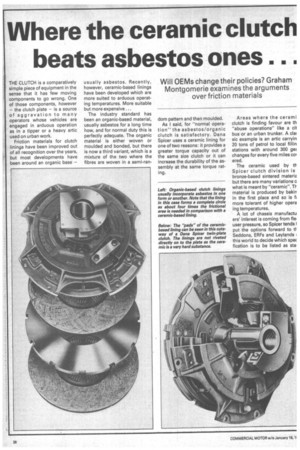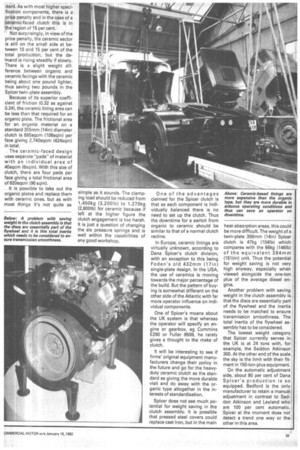Where the ceramic clutch beats asbestos ones . . .
Page 34

Page 35

If you've noticed an error in this article please click here to report it so we can fix it.
THE CLUTCH is a comparatively simple piece of equipment in the sense that it has few moving components to go wrong. One of those components, however — the clutch plate — is a source of aggravation to many operators whose vehicles are engaged in arduous operation as in a tipper or a heavy artic used on urban work.
Friction materials for clutch linings have been improved out of all recognition over the years, but most developments have been around an organic base — usually asbestos, Recently, however, ceramic-based linings have been developed which are more suited to arduous operating temperatures. More suitable but more expensive ...
The industry standard has been an organic-based material, usually asbestos for a long time how, and for normal duty this is perfectly adequate. The organic material is either woven or moulded and bonded, but there is now a third variant, which is a mixture of the two where the fibres are woven in a semi-ran dam pattern and then moulded.
As I said, for "normal operation" the asbestos/organic clutch is satisfactory. Dana Spicer uses a ceramic lining for one of two reasons: it provides a greater torque capacity out of the same size clutch or it can increase the durability of the assembly at the same torque rating. Areas where the cerami clutch is finding favour are th "abuse operations" like a cit bus or an urban trunker. A cla: sic example is an artic carryin 20 tons of petrol to local fillin stations with around 300 gec changes for every five miles col ered.
The ceramic used by th Spicer clutch division is bronze-based sintered materhe but there are many variations c what is meant by "ceramic". Th material is produced by bakin in the first place and so is fi more tolerant of higher opera ing temperatures.
A lot of chassis manufactu ers' interest is coming from fle, user pressure, so Spicer tends 1 put the options forward to th Seddons, ERFs and Leylands this world to decide which spec fication is to be listed as stal
dard. As with most higher specification components, there is a price penalty and in the case of a ceramic-faced clutch this is in the region of 15 per cent.
Not surprisingly, in view of the price penalty, the ceramic sector is still on the small side at between 10 and 15 per cent of the total production, but the demand is rising steadily if slowly. There is a slight weight difference between organic and ceramic facings with the ceramic being about one pound lighter, thus saving two pounds in the Spicer twin-plate assembly.
Because of its superior coefficient of friction (0.32 as against 0.24), the ceramic lining area can be less than that required for an organic plate. The frictional area for an organic material on a standard 355mm (14in) diameter clutch is 685sqcm (106sqin) per face giving 2,740sqcm (424sqin) in total.
The ceramic-faced design uses separate "pads" of material with an individual area of 40sqcm (6sqin). With this size of clutch, there are four pads per face giving a total frictional area of 620sgcm (96 sqin).
It is possible to take out the organic plates and replace them with ceramic ones, but as with most things it's not quite as simple as it sounds. The clamping load should be reduced from 1,450kg (3,2001b) to 1,270kg (2,8001b) for ceramic because if left at the higher figure the clutch engagement is too harsh. It is just a question of changing the six pressure springs and is well within the capabilities of any good workshop. One of the advantages claimed for the Spicer clutch is that as each component is individually balanced there is no need to set up the clutch. Thus the downtime for a switch from organic to ceramic should be similar to that of a normal clutch recline.
In Europe, ceramic linings are virtually unknown, according to Dana Spicer's clutch division, with an exception to this being Foden's old 432mm (17in) single-plate design. In the USA, the use of ceramics is moving towards the major percentage of the build. But the pattern of buying is somewhat different on the other side of the Atlantic with far more operator influence on individual components.
One of Spicer's moans about the UK system is that whereas the operator will specify an engine or gearbox, eg Cummins E290 or Fuller 9509, he rarely gives a thought to the make of clutch.
It will be interesting to see if firms' original equipment manufacturers change their policy in the future and go for the heavyduty ceramic clutch as the standard as giving the more durable visit and do away with the organic type altogether in the interests of standardisation.
Spicer does not see much potential for weight saving in the clutch assembly. It is possible that pressed steel covers could replace cast iron, but in the main
heat-absorption areas, this could be more difficult. The weight of a twin-plate 356mm (14in) Spicer clutch is 47kg (1041b) which compares with the 66kg (1461b) of the equivalent 3 9 4mm (151/2in) unit. Thus the potential for weight saving is not very high anyway, especially when viewed alongside the one-ton plus of the average diesel engine.
Another problem with saving weight in the clutch assembly is that the discs are essentially part of the flywheel and the inertia needs to be matched to ensure transmission smoothness. The total inertia of the flywheel assembly has to be considered.
The lowest weight category that Spicer currently serves in the UK is at 24 tons with, for example, the Seddon Atkinson 300. At the other end of the scale the sky is the limit with their fitment in 150-ton-plus equipment.
On the automatic adjustment, side, about 80 per cent of Dana , Spicer's production is so equipped. Bedford is the only. manufacturer to retain a manual adjustment in contrast to Seddon Atkinson and Leyland who are 100 per cent automatic. Spicer at the moment does not detect a trend one way or the other in this area.










































